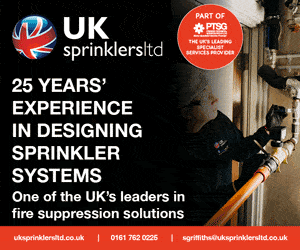As hybrid working becomes the norm, more and more companies are recognising the need to create a destination office that will attract and retain employees by offering more than just a place to work.
The pandemic saw a shift to remote working, driven by flexibility and an improved work / life balance which has had a direct impact on city centres and office space use. This changing culture means today a workplace has to speak to an employee’s sense of wellbeing as much as to their desire to do a good job.
It means workspace design, service excellence and facilities management all play a part in employee satisfaction and productivity.
Gary Seaton, Sales and Marketing Director, and John Norris, Head of Innovation at cleaning and security provider Samsic UK, look at how facilities management and the use of artificial intelligence (AI) can help create destination offices by providing healthier, happier workplaces.
From Gary’s perspective: “Creating a destination office today means aligning space with purpose – where AI, sustainability, and wellbeing intersect to support hybrid workforces.”
While John believes: “We’re not just cleaning offices; we’re transforming them into ESG-aligned, data-led spaces people want to return to.”
Today, many companies are facing real challenges in getting people to return to their workplace because employees have grown accustomed to the flexibility and balance offered by remote working. The decision to commute to a fixed place of work (or not) is weighed heavily against factors such as impact on wellbeing, opportunities to collaborate and socialise, as well as the overall quality of the workplace experience.
According to the Office for National Statistics Opinions and Lifestyle Survey1, more than a quarter (28%) of working adults in Great Britain in late 2024 were hybrid, splitting their working hours between the office and home.
Many companies are now demanding office attendance two or three days a week, or are even looking to cut the hybrid model altogether with a full-time return, but could such a change in attitude turn into a stampede for the door? According to WTW’s Global Benefits Attitudes Survey2, 52% of employees indicate they would quit or look to leave if their company mandated a full-time return to the company premises.
The return-to-office battle has never been felt more keenly. Therefore, forward-thinking companies are trying to entice people away from remote working – rather than just demanding it – by creating more appealing workplaces, which have been termed ‘destination offices’.
The ultimate aim of a destination office is to provide a space that promotes a sense of community and belonging, strengthens company loyalty and enables a deeper connection with company culture. It should provide flexibility for people to work in the way they want, in premises that are comfortable, engaging, clean and hygienic. It means developing an employee-centric ethos and providing an experience-driven workplace that meets people’s emotional and physical needs.
The question is: how do businesses achieve this while also keeping an eye on the bottom line?
Wellness programmes and ergonomic workspaces are a given, but there are more subtle nuances that help to create an enticing workspace, such as using AI and intelligent data analysis in facilities management to greatly improve user experience. By analysing data, companies can optimise predictive maintenance, on-demand cleaning and smart resourcing, to support the creation of dynamic, employee-friendly spaces.
AI can tell you what people do, what they want and what they like. It can monitor their use of the building, lifts, canteens, washrooms, tracking trends that may help businesses identify what people are doing that makes them come to the office rather than stay working from home.
A healthy, hygienic environment is a mainstay of a destination office, particularly in this post-COVID world. This is where facilities management can make a real impact, especially by improving wellbeing through intelligent hygiene. Data-led auditing can track hygiene standards and target areas for improvement – ensuring healthier indoor environments.
AI-led cleaning routines directly support the comfort and health of building occupants using sensor feedback to ensure spaces remain clean and inviting, while predictive replenishment ensures essentials, such as washroom products, are always available.
Touchpoint-focused cleaning and on-demand scheduling, which supports user comfort and safety, can be utilised, while scent management in reception areas can help to improve the sensory experience of employees and visitors.
Cleaning and security teams often operate with real-time feedback tools, allowing adjustments that improve comfort and user experience. It means site operatives can ensure shared spaces, such as washrooms, kitchens and breakrooms, remain clean, safe and welcoming.
If you look at Maslow’s Hierarchy of Needs3, it is AI that will help a destination office reach the top of that pyramid, covering physiological and safety requirements, creating social belonging, building self-esteem and achieving self-actualisation, where people can achieve their potential and feel a real purpose.
It is all about finding solutions so that you can move people’s mindsets from ‘I need to survive at the office’ to ‘I am happy to commute for an hour because I am going somewhere I want to be’.
AI can also provide energy and efficiency solutions helping to reduce water and chemical usage. Audits can also help to identify energy savings opportunities through LED lighting, and cleaning schedules that are tied to occupancy.
Therefore, a real benefit of AI for companies is how data analytics and AI-driven insights can support better service delivery, optimise building management, predictive maintenance, and operational efficiency.
The use of data can also support a company’s ESG targets, using data-led ESG gains, whether it is eliminating chemical usage, reducing single-use plastics, or tracking energy and material savings, AI can help clients meet their ESG targets with measurable results.
Physical changes can also have an impact on people’s perception of a building with many businesses also prioritising green cleaning, using methods and products that prioritise human and environmental health and employee wellbeing.
Facilities management can have a direct impact on the creation of a destination office, which in turn can enhance productivity, wellbeing, and culture.
Reimagining office space is one thing, but it goes far beyond just enticing workers back into the office. A destination office is a powerful tool in helping to retain top talent, boost morale and motivate a workforce, and facilities management has a strong role to play in this modern office trend.

























































